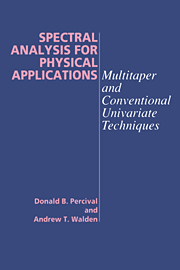Book contents
- Frontmatter
- Contents
- Preface
- Conventions and Notation
- Data and Software
- 1 Introduction to Spectral Analysis
- 2 Stationary Stochastic Processes
- 3 Deterministic Spectral Analysis
- 4 Foundations for Stochastic Spectral Analysis
- 5 Linear Time-Invariant Filters
- 6 Nonparametric Spectral Estimation
- 7 Multitaper Spectral Estimation
- 8 Calculation of Discrete Prolate Spheroidal Sequences
- 9 Parametric Spectral Estimation
- 10 Harmonic Analysis
- References
- Author Index
- Subject Index
10 - Harmonic Analysis
Published online by Cambridge University Press: 04 December 2009
- Frontmatter
- Contents
- Preface
- Conventions and Notation
- Data and Software
- 1 Introduction to Spectral Analysis
- 2 Stationary Stochastic Processes
- 3 Deterministic Spectral Analysis
- 4 Foundations for Stochastic Spectral Analysis
- 5 Linear Time-Invariant Filters
- 6 Nonparametric Spectral Estimation
- 7 Multitaper Spectral Estimation
- 8 Calculation of Discrete Prolate Spheroidal Sequences
- 9 Parametric Spectral Estimation
- 10 Harmonic Analysis
- References
- Author Index
- Subject Index
Summary
Introduction
If a stationary process has a purely continuous spectrum, it is natural to estimate its spectral density function (sdf) since this function is easier to interpret than the integrated spectrum. Estimation of the sdf has occupied our attention in Chapters 6, 7 and 9. However, if we are given a sample of a time series drawn from a process with a purely discrete spectrum (i.e., a ‘line’ spectrum for which the integrated spectrum is a step function), our estimation problem is quite different: we must estimate the location and magnitude of the jumps in the integrated spectrum. This requires estimation techniques that differ – to some degree at least – from what we have already studied. It is more common, however, to come across processes whose spectra are a mixture of lines and an sdf stemming from a so-called ‘background continuum.’ In Section 4.4 we distinguished two cases. If the sdf for the continuum is that of white noise, we said that the process has a discrete spectrum – as opposed to a purely discrete spectrum, which has only a line component; on the other hand, if the sdf for the continuum differs from that of white noise (sometimes called ‘colored’ noise), we said that the process has a mixed spectrum (see Figures 142 and 143).
In this chapter we shall use some standard concepts from tidal analysis to motivate and illustrate these models. We shall begin with a discrete parameter harmonic process that has a purely discrete spectrum.
Information
- Type
- Chapter
- Information
- Spectral Analysis for Physical Applications , pp. 456 - 545Publisher: Cambridge University PressPrint publication year: 1993
Accessibility standard: Unknown
- 1
- Cited by
